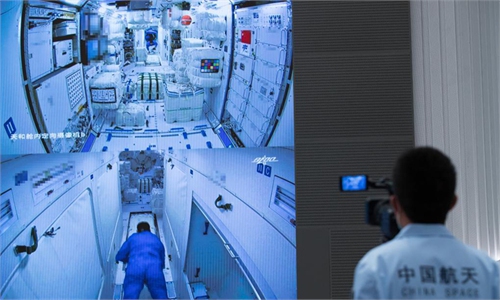Setting up Wi-Fi, unboxing deliveries – Taikonauts busy 'housewarming' on their 1st day in space
Chinese wisdom onboard supports record-long stay
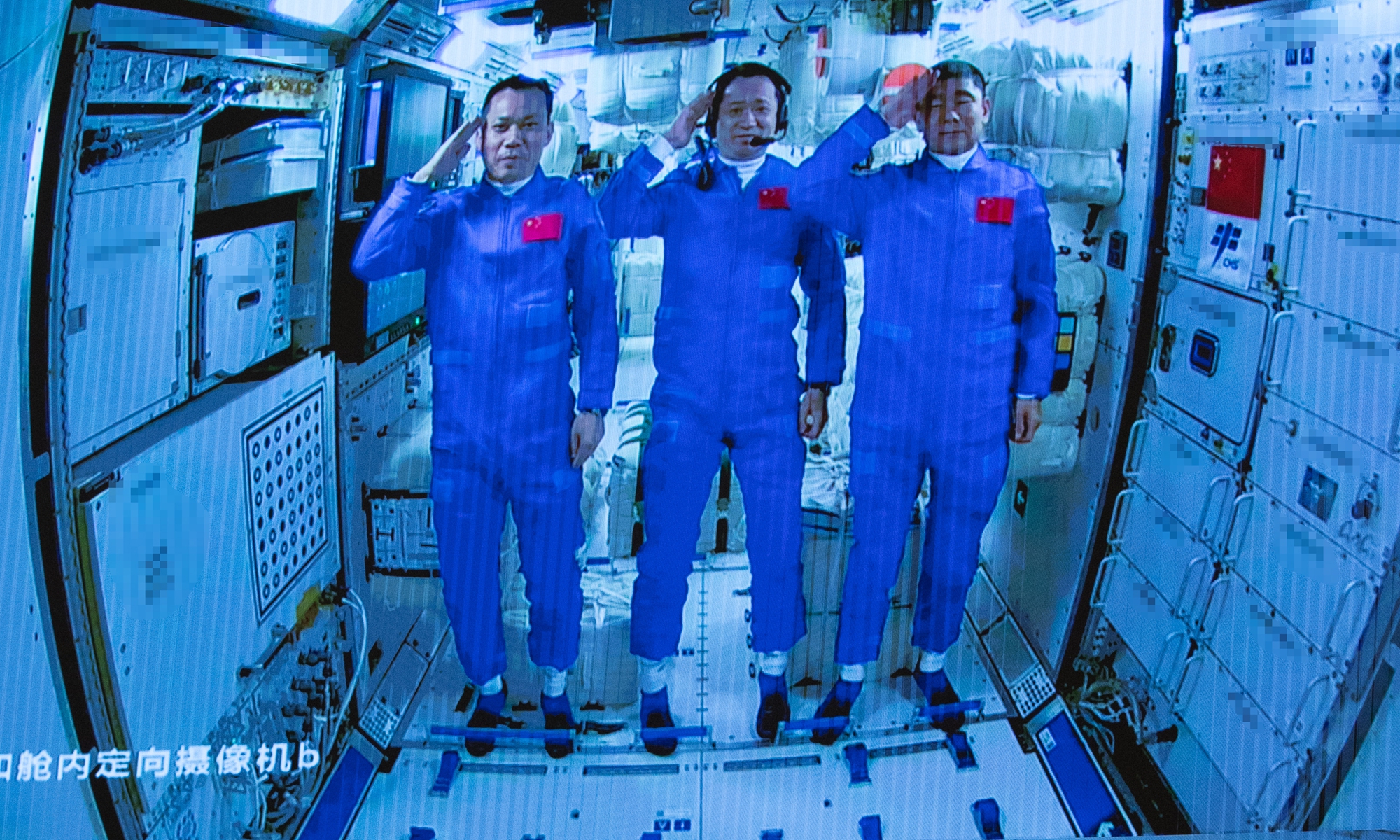
Three Shenzhou-12 astronauts, Tang Hongbo, Nie Haisheng and Liu Boming (from left) salute after entering the Tianhe core module on Thursday. Photo: Xinhua
Setting up Wi-Fi, unboxing supplies delivered from Earth… the taikonauts are busy engaged in housewarming at their new home - China's Tianhe space station core module about 400 kilometers above Earth, where they will stay for three months.
According to the China Manned Space Agency (CMSA), Nie Haishang, Liu Boming, and Tang Hongbo will keep a synchronized work and rest schedule between space and Earth. The Global Times learned from sources from the Beijing Aerospace Flight Control Center at around 9 am Friday morning that the crew just had their first breakfast in space.
Nie and his roommates also set up the Wi-Fi for their new home on Friday morning. CCTV said on Thursday the three are also expected on Friday to open the gate of the Tianzhou-2 cargo craft and unbox supplies that have arrived in advance.
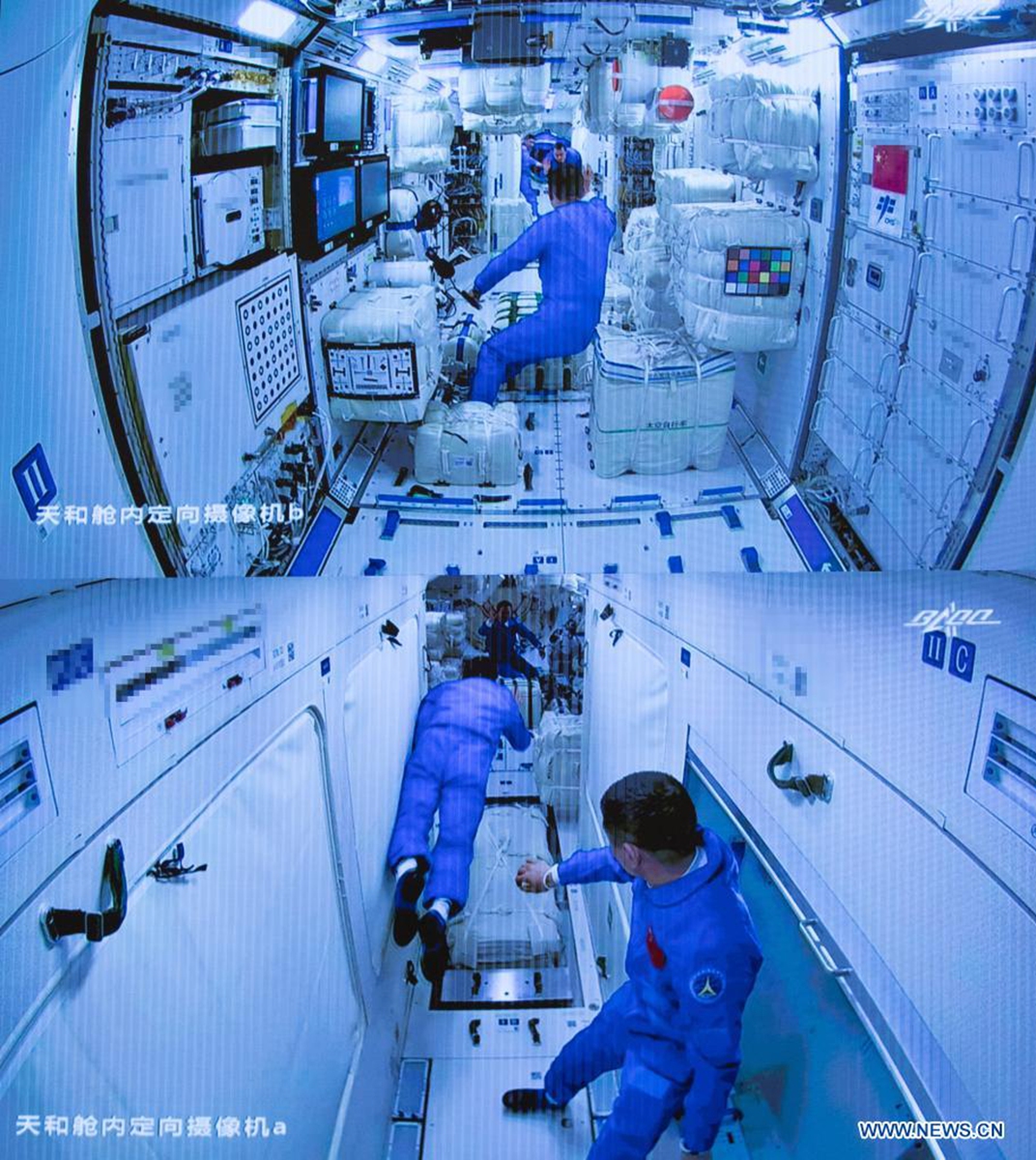
Screen image captured at Beijing Aerospace Control Center in Beijing, capital of China, June 17, 2021 shows three Chinese astronauts onboard the Shenzhou-12 spaceship entering the space station core module Tianhe. Photo: Xinhua
Unprecedented challenges
Huang Weifen, chief designer of the Chinese astronauts training system, noted in a group interview before the three set sail to space on Thursday morning that as the taikonauts are required to stay three to six months in orbit at the space station construction and key technology verifications phase, they will face unprecedented challenges.
Previously, the longest stay in space recorded by taikonauts was set by Jing Haipeng and Chen Dong during their Shenzhou-11 mission. The crew traveled 33 days in space.
Such challenges would range from how to maintain good physical health and overcome the adverse effects such as long-term stay in a weightless environment, among others such as strong vibration and loud noise in space, to how to deal with negative emotions that could be easily caused by a long separation from family and familiar places, according to Huang.
Furthermore, Huang said, the highly complex mission requirements including building and running a sophisticated space station would also pose challenges to astronauts' professional knowledge and skills.
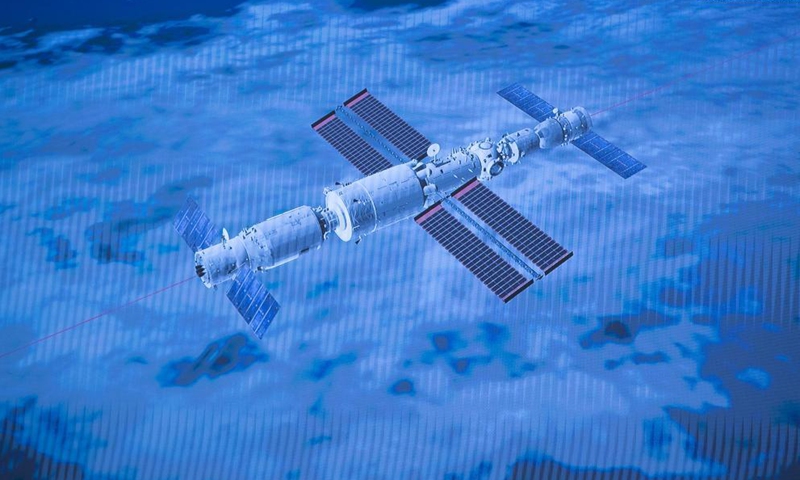
Screen image captured at Beijing Aerospace Control Center in Beijing, capital of China, June 17, 2021 shows China's Shenzhou-12 manned spaceship having successfully docked with the space station core module Tianhe. Photo: Xinhua
Bigger room
To tackle such challenges, the taikonauts have undertaken thousands of hours of special training. In addition, mission planners have also tried their best to make the taikonauts' stay in space as comfortable as possible.
The upgraded supporting system for the crew's work and life in space is another manifest of China's wisdom.
The room for in-cabin activities in China's space station has expanded greatly compared to that in China's previous manned orbiting spacecraft Tiangong 1 and 2, which is six times larger, from 15 cubic meters to 110 cubic meters when completed, the Global Times learned from the space station program contractor China Aerospace Science and Technology Corporation (CASC).
About 50 cubic meters is available inside the core module alone for occupants' living and work activities - much more room than in all previous crewed Chinese spacecraft, according to the CASC.
Seeing CCTV footage in which the crew was floating with ease in the spacious Tianhe cabin in awe, a great sense of pride was aroused among millions of Chinese netizens.
Even Yang Liwei, director of the China Manned Space Engineering Office and the country's first astronaut who visited space in the Shenzhou-5 mission in 2003, said with humor that he envied a lot to see his fellow spacemen now have such a big new home, which shows how China's space industry has advanced in the past 18 years.
With many recalling how Yang was literally crouching during his some 20 hours of space ride 18 years ago, netizens proudly nicknamed Tianhe a villa featuring three separate deluxe bedrooms, a broad living room, a bathroom, and even a gym for exercise.
Ji Qiming, CMSA spokesperson, revealed that such space gym is equipped with a bicycle and running platform to assist taikonauts' daily physical training.
Yang revealed that the Chinese station will grow even bigger when two lab cabins connect to the core module in the future.
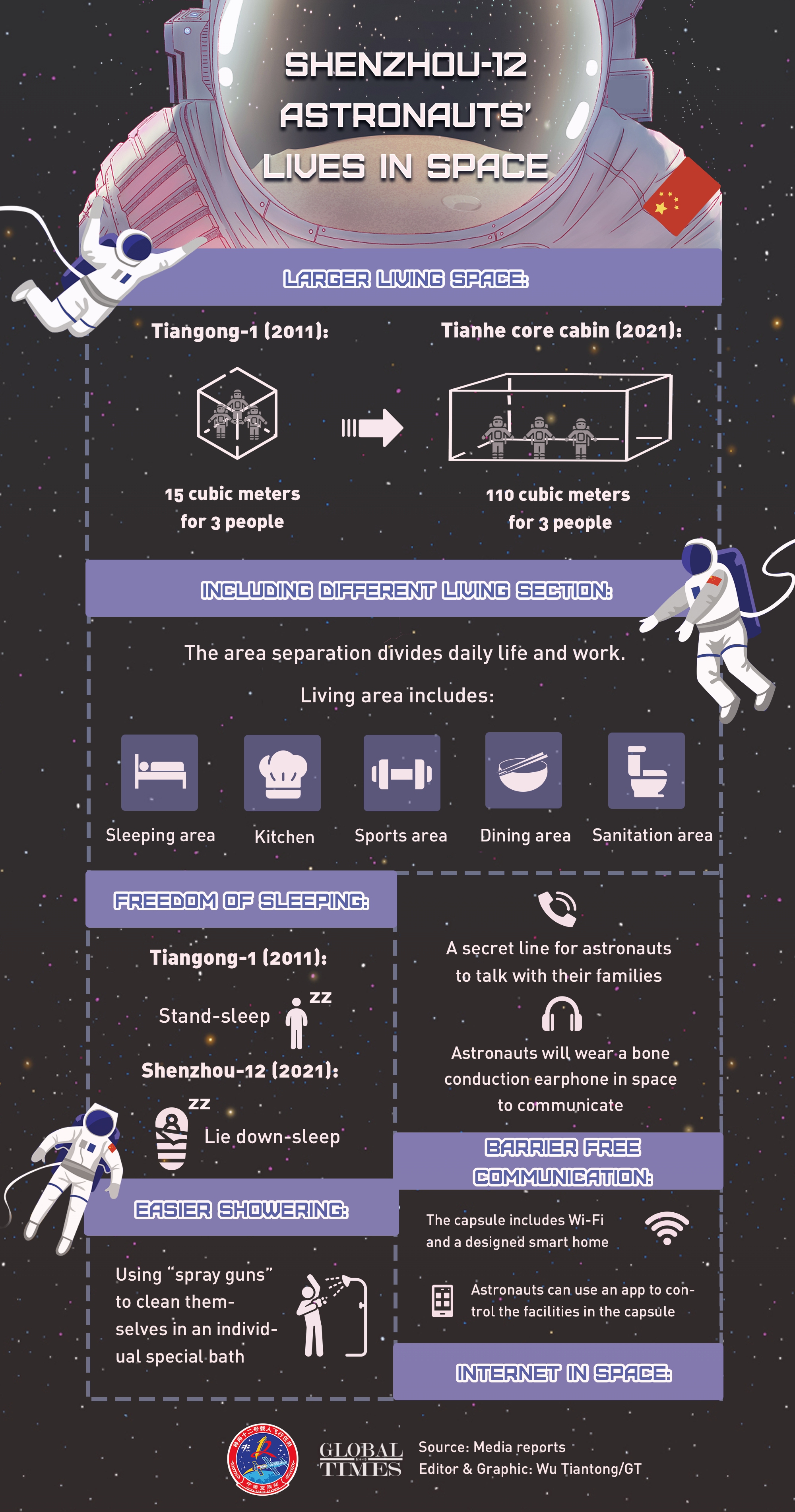
Shenzhou-12 astronauts' lives in space Infographic: Wu Tiantong/GT
Innovative solutions
A number of new technologies have also been applied on the core cabin, including information technology that allows broader bandwidth between space and Earth, and one-on-one private connections, as well as smart home applications that can be controlled by phone apps, providing a cozier living environment for taikonauts. Wireless communication is also equipped using Wi-Fi and Bluetooth technologies.
According to Bai Linhou, deputy chief designer of the Tianhe core module, the Wi-Fi system onboard Tianhe, enabling taikonauts' communication with ground, can reach speeds of up to 100 million bytes per second.
"That is to say, they can browse websites just as we can on the ground, and make phone calls with ground also… there would be no difference for them to use such services," Bai said.
Mission planners have also set up a private voice call channel for astronauts, which they can use to "talk secrets" with their families and share their feelings with people on the ground.
Prior to the crew's arrival on Thursday, the Tianzhou-2 cargo spacecraft shipped 6.8 tons of supplies, including some 160 parcels of goods and two tons of propellants, to the Tianhe core module, the Global Times learned from the craft developer CAST.
Ground logistics technology has also been adopted for the spacecraft. For example, astronauts can obtain the location and further information of specific goods by scanning a QR code, and the inventory information is recorded in a dynamic manner so that astronauts can keep track of the goods, Yang Sheng, the cargo spacecraft system's chief designer, disclosed.
Over 120 kinds of space food are available on the station with balanced nutrition, a rich variety, and good taste, CMSA said, among which are the celebrated Chinese favorites, Kung Pao Chicken and Yuxiang Shredded Pork.
China Aerospace Science and Industry Corporation (CASIC) told the Global Times on Friday that the firm has also offered a variety of high-tech solutions to support the lives of taikonauts in orbit, such as helping them build a space kitchen, space hospital as well as space air conditioning system.
CASIC has developed a food warmer that is installed on the Shenzhou-12, enabling astronauts to heat their food.
Taikonauts would also be carrying their space hospital devices which are also developed by the CASIC and come in the size of a cigarette pack. Such devices can record physical vitals such as body temperature, heart and breathing data in a real-time fashion and transmit data back to ground for further analysis.
CASIC has also contributed to the space air conditioner system with their products including the liquid circuit valve and gas flow control valve, components of the system, which allow the taikonauts to have a suitable working temperature environment.
Another key technology that will be brought to space on board is the urine processing and regenerative systems, said Li Jiandong, senior engineer in charge of the system.
"As a major breakthrough in the recycling of water resources in space, it is a crucial step to enable the long-term stay for astronauts in orbit, which serves as a key support role in the construction and operation of China's space station," a senior official at CASIC told the Global Times.
Six liters of urine can extract 5 liters of distilled water, and the maximum water production rate is 2.5 liters per hour, according to CASIC.
Shenzhou-12 manned spaceflight is the fourth mission in the key technologies verification phase, and also the first manned mission in the space station phase.
As the first batch of space residents in China's own space station, the three taikonauts are projected to achieve main mission objectives including verification of key technologies for the construction and operation of the space station such as taikonauts long-duration in-orbit stay, regenerative environment control and life support, and goods and materials resupplies.
Extravehicular activities and operations and in-orbit maintenance will also be highlight events for the crew's three-month stay, during which they will conduct for the first time a long-duration operation outside the cabin, with the support of robotic arms, according to Ji the CMSA spokesperson.
According to mission planners, there would be two spacewalk events in the mission period. Liu, who had participated in the country's first spacewalk together with Zhai Zhigang during the Shenzhou-7 mission, is expected to play a crucial guiding role during outside cabin operations.
After a stay of three months, the astronauts will return to the Dongfeng landing site located in the desert of North China's Inner Mongolia Autonomous Region onboard the re-entry capsule.
Throughout the mission period, the Xi'an Satellite Control Center will work together with the Beijing Aerospace Control Center to track and monitor the mission, the Xi'an center told the Global Times.
Deploying its stations in over 10 regions across the country, including Kashi, Weinan, Qingdao, Xiamen and Hetian, the Xi'an center will track the real-time status of in-orbit taikonauts throughout their three-month stay.

Space time. Photo: GT

